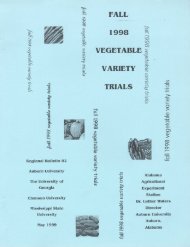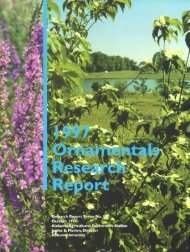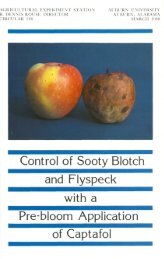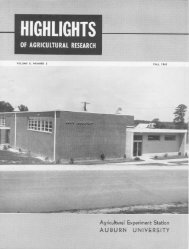MARKETING CHRISTMAS TREES - Auburn University Repository
MARKETING CHRISTMAS TREES - Auburn University Repository
MARKETING CHRISTMAS TREES - Auburn University Repository
You also want an ePaper? Increase the reach of your titles
YUMPU automatically turns print PDFs into web optimized ePapers that Google loves.
16 ALABAMA<br />
AGRICULTURAL EXPERIMENT STATION<br />
crease in retail price of about 50 cents per 1-foot increase in<br />
height for small to medium size and 33 cents per foot for medium<br />
to large size trees. These figures are fairly close to the spreads<br />
by size recently reported in California (6) and Michigan (5). There<br />
were few quotations on the very large trees, which of course<br />
varied considerably in size. Premiums for tinting trees varied,<br />
but a limited number of quotations indicated a tendency to charge<br />
about $0.40 per foot in height for tinting the small and medium<br />
"popular sized" trees.<br />
No meaningful wholesale quotations were obtained on cedar,<br />
pine, and Arizona cypress trees of local growth or "short haul"<br />
from Tennessee. Most handlers "dickered" with retailers, disposing<br />
of their load at what they considered the best bid, or<br />
breaking the load into parts and selling each part the most advantageously.<br />
Some retailers reported paying an average of over<br />
$1 per tree for those of medium size. Others reported buying<br />
trees for a few cents per tree. Some said cedars were given them<br />
for the cutting. One retailer paid 10 cents each for suitable trees<br />
provided he cut and left in the fields those he did not want. Of<br />
course, harvesting costs were involved. Thus, the retailer's "delivered"'<br />
cost was substantially higher.<br />
Retail price quotations on cedars were numerous and quite<br />
variable, Table 8. Cedars were priced lower than imported trees<br />
of the same height. Small and medium cedars were priced about<br />
25 per cent lower and large trees about 15 per cent lower than<br />
imported trees. While no grading was undertaken, it appeared<br />
that a higher proportion of cedars were essentially culls, qualitywise,<br />
than were imported trees. The relative ease with which<br />
cedars could be obtained must have encouraged some haulers to<br />
move many poorly shaped and otherwise low quality trees to<br />
market. They were in some instances included in a purchase of<br />
TABLE 8. RETAIL PRICES OF NATURAL COLOR CEDAR 1 <strong>CHRISTMAS</strong> <strong>TREES</strong>, BY SIZE<br />
OF TREE, 11 SELECTED MARKETS, ALABAMA, 1956<br />
Size of Usual Retail price per tree<br />
tree height Quotations Range Average<br />
Feet Number Dollars Dollars<br />
Small Less than 4.0 38 0.50-2.00 0.98<br />
Medium 4.0-5.9 52 .75-5.00 1.72<br />
Large 6.0-8.9 43 1.25-7.00 2.84<br />
Very large 9.0 or more 0<br />
' Largely state-grown varieties or shipped in from southern Tennessee.
















